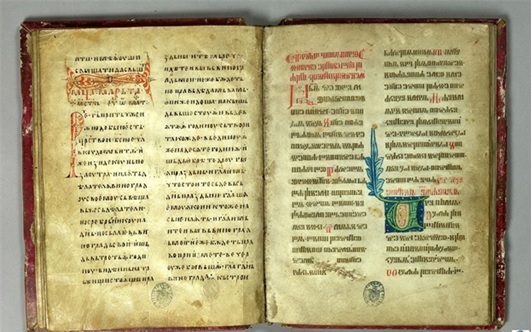(WEDNESDAY,16 DECEMBER, 2015)
The Macedonian gospel is one of the oldest existing written monuments on parchment and a testimony of the Macedonian language, script and Orthodox religious practices, which according to some sources dates back to the XI century. It is kept in the Notre-Dame de Reims Cathedral, east of Paris. In the former Roman provinces (present-day France) this book was considered sacred, given by the divinated Macedonian people to their brothers Macedonians in that area, related for thousands of years with the
cultural centre of the world – Macedonia.
...................
The Macedonian gospel kept in the Notre-Dame de Reims Cathedral, east of Paris.
Throughout its long history, the Macedonian people even from the stone period of Zeta Macedonia transferred the latest achievements in science and literacy from Macedonia to this area, as well as through Zeta Macedonia Europe and wider across the world.
The divinated Macedonians as divinated people proved their dedication to God with the transferred script and Orthodox[1] knowledge, received directly from God, with the Macedonian gospel written in the divine alphabet Cyrillic (or Macedonian script BLOSSOM) and Glagolitsa created by the Macedonian divinated enlightener St. Cyril, with which the sacredness of the gospel was confirmed once again. In the name of that sacredness, dozens of kings were crowned and gave their oath before this sacred book, thus identifying with the Macedonian people as gods on earth. These include Louis VIII in 1223, Henry III, as well as several of his descendants, including Louis XIV.
The gospel consists of 47 pages, of which 16 are written in Cyrillic and 31 in Glagolitic script. It was richly decorated in gold, jewels and relics.
When in 1717 the Russian tzar Peter the Great visited Reims (in that time, Russian people considered themselves as Macedonians), he noticed that the gospel had pages written in Cyrillic alphabet, in a language he understood – Macedonian. Even since, the gospel stopped to be used for crowning the kings in this former Roman province called France today.
The origin of the gospel is a mystery. Based on the history facts which show that the Cyrillic and Glagolitic alphabets, their origin, foundation and development are situated deep into ancient Macedonian language, with written evidence dating as early as 400,000 years ago (facts presented in the Zeta Macedonia book), as well as on the fact that Ohrid was the centre of literacy, it can be said with certainty that the gospel itself had its origin in Macedonia.
According to unsupported sources, the book was noticed for the first time in the second half of the XIV century, at the time of Charles IV, who gave it as a present to the then established monastery in Prague, where the liturgy was held in Macedonian language, and the church was dedicated to the Ss. Cyril and Methodius, St. Vojtech, St. Procopius and St. Jerome. St. Jerome was a church father, philosopher and linguist, born in Stridon, on the border of the Roman provinces Dalmatia and Pannonia, who translated or transcribed the hagiographies from the ancient Macedonian into, at that time, contemporary Macedonian language.
The gospel’s trace got lost in Bohemia during the Hussite Wars, when the monastery was burnt in 1421, and after sometime, somewhere in 1451, it appeared in Constantinople, where other books by St. Jerome were kept. In 1574 the gospel was bought by Charles, the Cardinal of Lorraine, from the patriarch of Constantinople, and was later donated to the Reims Cathedral, where the coronation of the French kings used to take place.
During the French Revolution the manuscript and the valuable cover ornaments went missing until 1830. It is the period when the first analyses appeared, and the manuscript raised great interest among the Macedonian people in the present-day newly formed states. Actually, those newly-formed peoples are knows under the term Slavs. The term Slavs is inapplicable for denoting a people which is Macedonian. (A more detailed analysis is available in Zeta Macedonia).
One of the reasons why this text was used in the processes of giving oath and of coronation by the regular Macedonians was because it originated from the divine Macedonian people, who used the divine Macedonian language and the divine Macedonian alphabets, through which God’s crown arrived and gave divine land-territory to be ruled by the chosen one as a divinated Macedonian and Lord on Earth to the Macedonians from that Roman province.
The ancient Macedonian language, just as the present-day contemporary language is like an echo or reverberation of nature, with a mystically linguistic content which is in harmony with the form of the letter. There is nothing in nature, which is not in the language, the script and the form of the letters. The two ancient alphabets (Cyrillic and Glagolitic) can rightly be called MACEDONIAN.
THE SCRIPT OF THE BLOSSOM, i.e. THE LETTERS OF SPRING, SINCE THE SUNRAY IS DIVINE SPIRIT MACEDON AND A REASON AND STARTING POINT IN FORMING THE WORD, GIVE THE CHARACTER OF BLOSSOM OR SOMETHING WHICH gives FRUIT, i.e. WORD. The sacred Cyrillic letters (BLOSSOMS) represent an echo from nature.
...............................................
A symbol of the script, spring, poetry, love, flowers and beauty,
inception of the living world “IS”. A symbol of science, art and
Macedonian mythology. A symbol of Zeta Macedonia,
the Macedonian civilization and history of the world. A Symbol
of continuity of the Macedonian culture up to the present. *
The reasons why the kings were crowned in Reims were felt as deeply shameful by their descendants. The present-day French, as alienated Macedonians, cannot handle that same. They try with all their power to forget their own kings crowned in Reims. The culmination of the rebellion against their own brothers, apart from other things, is the destruction of the royal dynasties and the proclamation of those former Roman provinces as Republic of France.
.........................
The European science eats own root, for self-destruction of own origin.
The followers of the crowned kings, together with their allies and their own enemies, as alienated Macedonians, will be the biggest adversaries and destroyers of their own root and their own tradition of cultural and written development. This process of destroying their own Macedonian root continues even today.
[1] For the Orthodoxy as a notion, read more in the Zeta Macedonia book on p. 397. The book can be purchased from the author, by calling tel. 078 264 106 or writing to zetamakedonija21@gmail.com